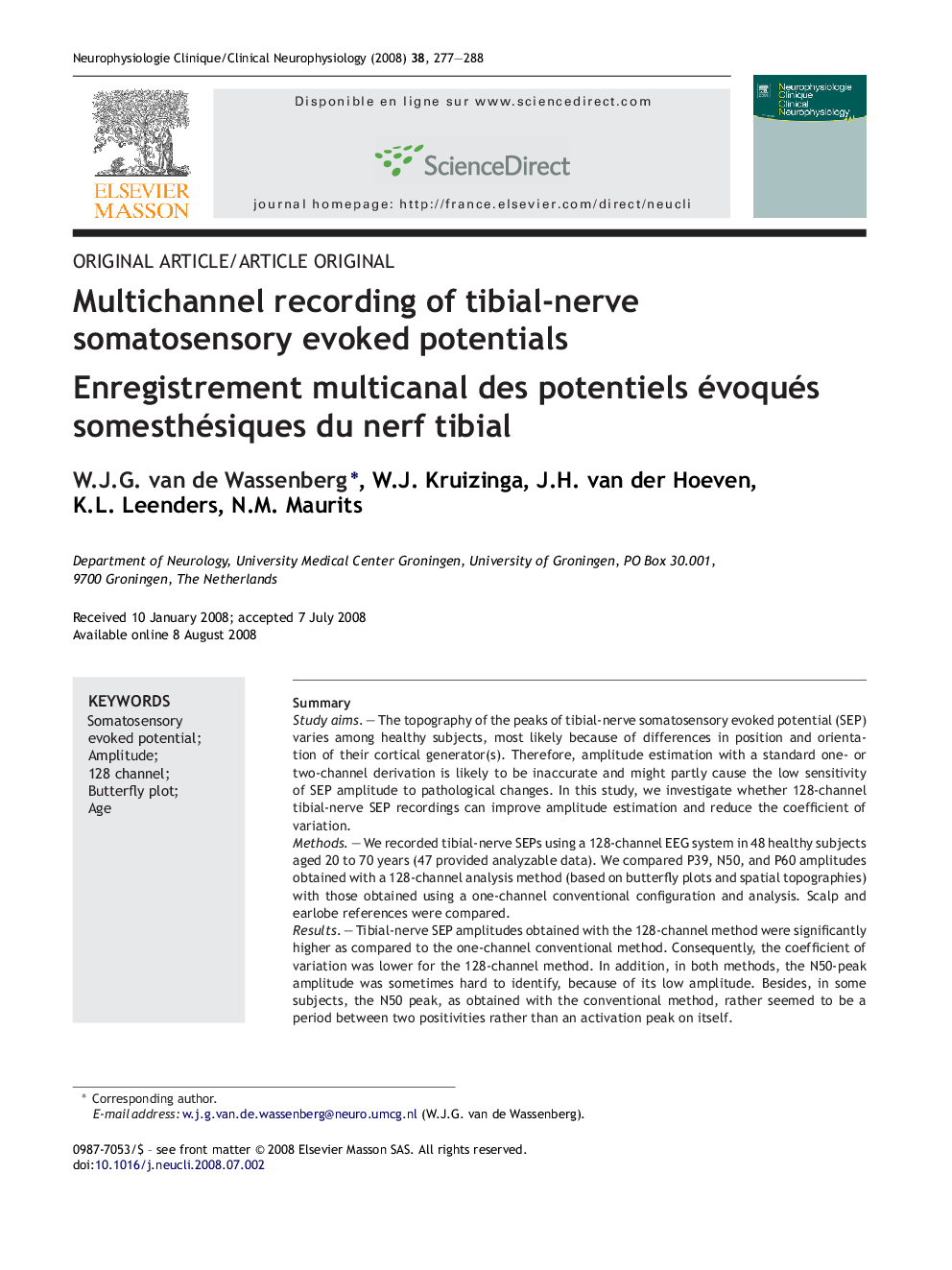| Article ID | Journal | Published Year | Pages | File Type |
|---|---|---|---|---|
| 3083145 | Neurophysiologie Clinique/Clinical Neurophysiology | 2008 | 12 Pages |
SummaryStudy aimsThe topography of the peaks of tibial-nerve somatosensory evoked potential (SEP) varies among healthy subjects, most likely because of differences in position and orientation of their cortical generator(s). Therefore, amplitude estimation with a standard one- or two-channel derivation is likely to be inaccurate and might partly cause the low sensitivity of SEP amplitude to pathological changes. In this study, we investigate whether 128-channel tibial-nerve SEP recordings can improve amplitude estimation and reduce the coefficient of variation.MethodsWe recorded tibial-nerve SEPs using a 128-channel EEG system in 48 healthy subjects aged 20 to 70 years (47 provided analyzable data). We compared P39, N50, and P60 amplitudes obtained with a 128-channel analysis method (based on butterfly plots and spatial topographies) with those obtained using a one-channel conventional configuration and analysis. Scalp and earlobe references were compared.ResultsTibial-nerve SEP amplitudes obtained with the 128-channel method were significantly higher as compared to the one-channel conventional method. Consequently, the coefficient of variation was lower for the 128-channel method. In addition, in both methods, the N50-peak amplitude was sometimes hard to identify, because of its low amplitude. Besides, in some subjects, the N50 peak, as obtained with the conventional method, rather seemed to be a period between two positivities rather than an activation peak on itself.ConclusionsThe 128-channel method can measure tibial-nerve SEP amplitude more accurately and might therefore be more sensitive to pathological changes. Our results indicate that the N50 component is less useful for clinical practice.
RésuméObjectifsLa variabilité interindividuelle de la topographie des différents pics du potentiel évoqué somesthésique (PES) du nerf tibial observée chez les sujets sains peut s’expliquer par des différences de position et d’orientation de leurs générateurs corticaux. Il existe donc un risque d’erreur de mesure de leur amplitude lorsque les enregistrements sont réalisés sur un ou deux canaux standard. Cela pourrait expliquer, en partie, la faible sensibilité de l’amplitude des PES aux altérations pathologiques. Dans cette étude, nous examinons si des enregistrements sur 128 canaux permettent d’améliorer l’estimation de l’amplitude des PES et de réduire leur coefficient de variation.MéthodesNous avons enregistré les PES du nerf tibial, en utilisant un système EEG à 128 canaux sur un groupe de 48 sujets sains âgés de 20 à 70 ans (47 sujets analysables) et comparé les amplitudes des pics P39, N50 et P60 obtenues avec une méthode d’analyse à 128 canaux (basée sur des diagrammes papillons et des topographies spatiales) aux amplitudes obtenues en utilisant la configuration et l’analyse conventionnelle à un canal. Des références au niveau du cuir chevelu et du lobe de l’oreille ont été comparées.RésultatsLes amplitudes obtenues avec la méthode à 128 canaux ont été significativement plus élevées par rapport à la méthode conventionnelle à un canal. Par conséquent, le coefficient de variation a été plus faible pour la méthode à 128 canaux. De plus, dans les deux méthodes, l’amplitude du pic N50 a été parfois difficile à identifier, en raison de sa faible amplitude. Chez certains sujets, le pic N50 obtenu avec la méthode conventionnelle semble davantage une image construite entre deux positivités qu’un pic en lui-même.ConclusionsLa méthode à 128 canaux permet de mesurer plus précisément l’amplitude des PES du nerf tibial et pourrait être, par consequent, plus sensible à leurs altérations en pathologie. Nos résultats indiquent également que la composante N50 est moins utile en pratique clinique.
